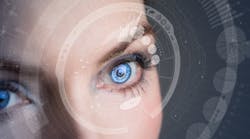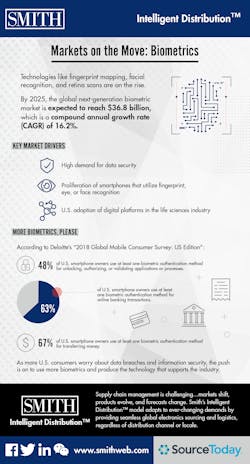Biometrics is big business. Defined as biological measurements or physical characteristics used to identify individuals, it includes technology like fingerprint mapping, facial recognition, and retina scans. The theory is that because physical characteristics are relatively fixed and individualized (even for twins), they can replace or at least augment password systems for computers, phones, and restricted access rooms and buildings.
By 2025, Zion Market Research expects the global next-generation biometric market to reach $36.8 billion, up from $12.9 billion last year. With a compound annual growth rate (CAGR) of 16.2%, the market offers up options that replace more traditional means of identifying individuals, such as documents (driver’s licenses, passports, etc.) and personal identification numbers (PINs).
“The introduction of the biometric system has made the verification of individuals for the purpose of security and safety easier and user-friendly,” Zion reports, noting that biometric technology also offers several benefits to the users, such as a high degree of privacy, accuracy, uniformity across systems, interoperability, and ease of use.
“The next generation biometric market is likely to grow owing to the increasing government initiatives for restricting illegal activities, growing e-passport programs, and the rising number of terrorist and criminal activities that require a high level of security,” it continues.
Key Market Drivers
The biometrics market is also being driven by high demand for data security, along with the proliferation of smartphones that utilize fingerprint, eye, or face recognition. And while Zion says that the growing use of biometrics in cloud computing and smartphones will help propel the market, it also says that the “high cost of biometric systems and risk of privacy intrusion may hamper this market.”
According to Zion, North America dominated the next-generation biometric market globally in 2018, primarily because of the growing number of IT companies; the easy availability of skilled personnel for conducting the biometric verifications; and various government initiatives to restrict illegal activities across the region.
“The U.S. holds the predominant position in this regional market and will maintain its dominance over the forecasted time period (2019-2025) as well,” the firm reports. “This can be attributed to various technological advancements and the rising number of government initiatives encouraging the adoption of digital platforms in the life sciences industry.”
The recent Capital One data breach and similar, highly-publicized events could also help drive growth in the biometric market, which multi-factor authentication solution provider Veridium says most consumers (about 70%) are willing to embrace in order to gain better data and information security.
“Cyberattacks have doubled in the first half of 2019, and companies are increasingly looking for ways to mitigate security risks,” Veridium’s Jason Tooley points out in “Recent data breach highlights need for biometric best practice” . “One way they are doing this is by moving to a passwordless environment to lower the chances that either employee or customer passwords could be leveraged by threat actors. As recent security incidents have shown, passwords no longer protect a firm’s data.”
For example, Microsoft is championing passwordless authentication by replacing passwords with biometrics for employee access this year and expecting other companies to follow suit within six years, Tooley writes, adding that companies must take a “strategic and secure approach” when using biometrics to avoid increasing the risk of a cyberattack instead of reducing it.
“This week, security researchers discovered a trove of unsecured biometric data,” he writes, “including 1 million fingerprints and facial recognition data. This information was found on a publicly accessible database. Whether attackers accessed this data before it was secured is unclear.”
More Biometrics, Please
As more companies experiment with biometric authentication, expect its originators to continue addressing privacy concerns and other issues that come along with the technology’s expanded usage. According to Deloitte’s “2018 global mobile consumer survey: US edition”, biometric authentication has attained critical mass and has grown among U.S. consumers, particularly for people who use their smartphones for financial transactions.
According to the survey, nearly half (48%) of U.S. smartphone owners use at least one biometric authentication method for unlocking, authorizing, or validating applications or processes. Penetration is even higher among consumers who use their smartphones for financial activities such as online banking transactions (63%) or transferring money (67%).
“Consumers are becoming increasingly aware of data breaches, unauthorized data sharing, and personal data theft. They understand the risk and want to have more ownership and control over their data,” Deloitte reports. “To protect their digital identity, U.S. consumers are increasingly relying on biometric authentication.”











